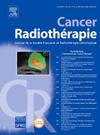Moderate hypofractionated radiotherapy for localised prostate cancer: A new standard of care
IF 1.4
4区 医学
Q4 ONCOLOGY
引用次数: 0
Abstract
Radical radiotherapy is an effective treatment and standard of care for localised prostate cancer. Most conventionally treatment has been given with 1.8 to 2.0 Gy fractions to a dose of 74 to 79.2 Gy. Radiobiology insights have encouraged the exploration of hypofractionated schedules. Over 7000 patients have contributed to eight randomised controlled trials comparing conventional fractionation with modest hypofractionation using 2.4 to 3.4 Gy fractions. These studies have used both non-inferiority statistical designs aiming to define isoeffective and isotoxic moderate hypofractionated radiotherapy schedules as well as dose-escalated hypofractionated schedules intended to show improved disease control whilst maintaining a low level of late side effects. Long-term follow-up of over 10 years is now available from four of the studies. Patients with low-high risk disease have been studied treating with or without androgen-deprivation. Meta-analysis of individual patient data from seven available trials has been performed with median follow-up of 5 to 7 years. The studies of isoeffective moderate hypofractionated radiotherapy show that a dose of 60 Gy in 3 Gy fractions delivered over 4 weeks is non-inferior to doses of 74 Gy to 78 Gy in 2 Gy fractions delivered over 7.4 to 7.8 weeks with similar levels of disease control and survival. Low levels of late side effects were maintained using intensity-modulated radiotherapy techniques. In distinction trials using dose-escalated hypofractionated schedules have not increased effectiveness and have raised levels of late side effects. This may relate to very modest hypofractionation and treatment protraction. There is now adequate evidence for radiotherapy delivering 60 Gy in 20 fractions over 4 weeks to be the standard schedule for all patients with localised prostate cancer.
中度低分割放疗治疗局限性前列腺癌:一种新的治疗标准
根治性放射治疗是局部前列腺癌的有效治疗方法和标准治疗方法。大多数常规治疗都是以1.8至2.0戈瑞的分量给予74至79.2戈瑞的剂量。放射生物学的见解鼓励了对低分割时间表的探索。超过7000名患者参与了8项随机对照试验,比较了常规分馏和使用2.4至3.4 Gy分数的适度低分馏。这些研究采用了两种非劣效性统计设计,旨在确定等效和等毒性中等低分割放疗方案,以及剂量递增的低分割放疗方案,旨在显示疾病控制的改善,同时保持低水平的后期副作用。目前已有四项研究进行了超过10年的长期随访。对低-高风险疾病患者进行了雄激素剥夺或非雄激素剥夺治疗的研究。对来自7项现有试验的个体患者数据进行了荟萃分析,中位随访时间为5至7年。等效中等低分割放疗的研究表明,在4周内给予3 Gy的60 Gy剂量,不低于在7.4至7.8周内给予2 Gy的74 Gy至78 Gy剂量,具有相似的疾病控制和生存水平。使用调强放疗技术维持低水平的晚期副作用。在不同的试验中,使用剂量递增的低分割方案并没有提高有效性,反而增加了后期副作用的水平。这可能与非常适度的切开和治疗延长有关。现在有充分的证据表明,在4周内分20次给予60戈瑞的放射治疗是所有局限性前列腺癌患者的标准治疗方案。
本文章由计算机程序翻译,如有差异,请以英文原文为准。
求助全文
约1分钟内获得全文
求助全文
来源期刊

Cancer Radiotherapie
医学-核医学
CiteScore
2.20
自引率
23.10%
发文量
129
审稿时长
63 days
期刊介绍:
Cancer/radiothérapie se veut d''abord et avant tout un organe francophone de publication des travaux de recherche en radiothérapie. La revue a pour objectif de diffuser les informations majeures sur les travaux de recherche en cancérologie et tout ce qui touche de près ou de loin au traitement du cancer par les radiations : technologie, radiophysique, radiobiologie et radiothérapie clinique.
 求助内容:
求助内容: 应助结果提醒方式:
应助结果提醒方式:


